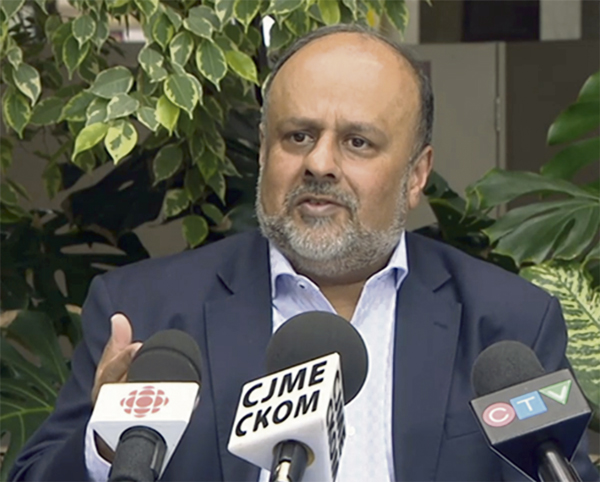Updated as of 4:54 p.m., Thursday, June 25.
Saskatchewan saw three new COVID-19 cases and five more recoveries on Thursday. Also included in the province’s daily report, however, was an increase of four hospitalizations.
As of Thursday, a total of nine people with COVID-19 are in hospital—seven are receiving inpatient care, four in the south, two in the north and one in Saskatoon, and two people are in the intensive care unit, one in the north and one in Saskatoon.
Two of the new cases are located in the far north and one is located in the Saskatoon area.
These new figures bring the province’s total number of cases since the beginning of the pandemic to 759, 648 of which have recovered.
Ninety-eight cases are considered active, a slight drop from 101 on Wednesday. Fifty four of the active cases are in the far north, two are in the north, 10 are in the Saskatoon area and 32 are in the south.
Of the 759 cases in the province:
- 157 cases are related to travel, 459 are community contacts (including mass gatherings), 100 have no known exposures and 44 are under investigation by local public health.
- 55 cases are health care workers; however, the source of the infections is not related to their work places in all instances.
- 316 of the cases are from the far north, 186 are from the Saskatoon area, 112 are from the north, 80 are from the Regina area, 53 are from the south and 12 are from the central region.
- 107 cases involve people 19 years of age and under, 260 cases are in the 20-39 age range, 241 are in the 40-59 age range, 130 are in the 60-79 age range and 21 are in the 80-plus range.
- 51 per cent of the cases are females and 49 per cent are males.
- 13 deaths related to COVID-19 have been reported.
To date, 62,435 COVID‐19 tests have been performed in Saskatchewan. As of June 23, when other provincial and national numbers were available from the Public Health Agency of Canada, Saskatchewan’s per capita rate was 46,773 people tested per million population. The national rate was 67,005 people tested per million population.
Government releases more data on Sask. COVID-19 cases
The Saskatchewan government has released a further breakdown of the province’s COVID-19 cases, and Chief Medical Health Officer Dr. Saqib Shahab says the numbers are on par with other jurisdictions.
Fifty-eight per cent of people who have been diagnosed with the virus have reported having a cough, followed by a fever, headache and sore throat. The least reported symptom, at 10 per cent, is joint pain.
Shahab said data shows that women are more likely to get tested, even if they have mild symptoms, yet men with COVID-19 are more likely to be hospitalized.
The province has seen 51 hospitalizations in total. Eighteen of those cases, at some point, were in the intensive care unit.
Hospitalizations have occurred in every age group, including one male in the zero to 19 age range.
Deaths are more common in the older age groups, with one person in the 40 to 59 age group, eight people in the 60 to 79 age group and four people 80 and over passing away.
The far north and north regions have been hit the hardest when it comes to hospitalizations and deaths. In total, the far north has seen 19 hospitalizations and the north has seen 13. The far north has had six deaths and the north has had three.
In Thursday’s news conference to discuss the numbers, Shahab also provided more information on how cases are attributed. On the same day, the provincial government noted that one case in the south, which was reported on June 18, was removed from the provincial count because their residence is outside of Saskatchewan.
“The attribution rules are quite complex,” said Shahab. “There can be a variety of contexts.”
He said people can be visiting family or travelling for work, for example, outside of their home province. It also depends on whether the person is well enough to travel back or if they have to carry out their two-week isolation period where they are.
Public health will ask the same questions when they come across a close contact of a positive case.
“Maybe we’ve got six cases who were diagnosed outside of Saskatchewan, we gave back nine cases who were diagnosed in Saskatchewan, but belong to another province,” estimated Shahab.
“The numbers are fairly low and overall don’t make too much of a difference.”
He said the attribution process was discussed on a national level to avoid double counting cases.


